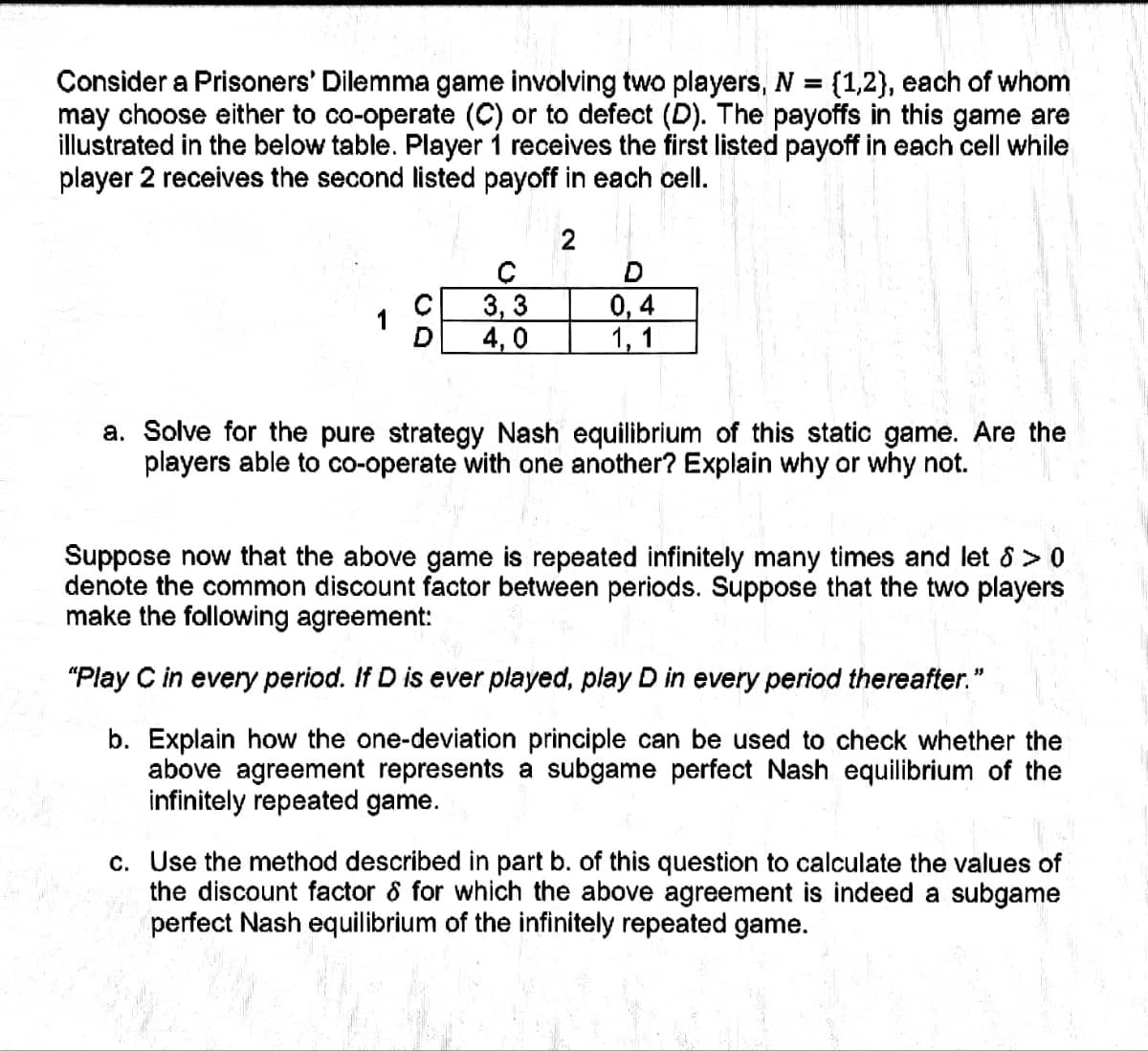Consider a Prisoners' Dilemma game involving two players, N = {1,2), each of whom may choose either to co-operate (C) or to defect (D). The payoffs in this game are illustrated in the below table. Player 1 receives the first listed payoff in each cell while player 2 receives the second listed payoff in each cell. 2 с 3,3 4,0 D 0,4 1,1 a. Solve for the pure strategy Nash equilibrium of this static game. Are the
Consider a Prisoners' Dilemma game involving two players, N = {1,2), each of whom may choose either to co-operate (C) or to defect (D). The payoffs in this game are illustrated in the below table. Player 1 receives the first listed payoff in each cell while player 2 receives the second listed payoff in each cell. 2 с 3,3 4,0 D 0,4 1,1 a. Solve for the pure strategy Nash equilibrium of this static game. Are the
Chapter15: Imperfect Competition
Section: Chapter Questions
Problem 15.5P
Related questions
Question

Transcribed Image Text:Consider a Prisoners' Dilemma game involving two players, N = {1,2}, each of whom
may choose either to co-operate (C) or to defect (D). The payoffs this game are
illustrated in the below table. Player 1 receives the first listed payoff in each cell while
player 2 receives the second listed payoff in each cell.
2
с
3,3
4,0
D
0,4
1, 1
a. Solve for the pure strategy Nash equilibrium of this static game. Are the
players able to co-operate with one another? Explain why or why not.
Suppose now that the above game is repeated infinitely many times and let 8 > 0
denote the common discount factor between periods. Suppose that the two players
make the following agreement:
"Play C in every period. If D is ever played, play D in every period thereafter."
b. Explain how the one-deviation principle can be used to check whether the
above agreement represents a subgame perfect Nash equilibrium of the
infinitely repeated game.
c. Use the method described in part b. of this question to calculate the values of
the discount factor & for which the above agreement is indeed a subgame
perfect Nash equilibrium of the infinitely repeated game.
Expert Solution
This question has been solved!
Explore an expertly crafted, step-by-step solution for a thorough understanding of key concepts.
This is a popular solution!
Trending now
This is a popular solution!
Step by step
Solved in 2 steps with 1 images

Knowledge Booster
Learn more about
Need a deep-dive on the concept behind this application? Look no further. Learn more about this topic, economics and related others by exploring similar questions and additional content below.Recommended textbooks for you


Managerial Economics: A Problem Solving Approach
Economics
ISBN:
9781337106665
Author:
Luke M. Froeb, Brian T. McCann, Michael R. Ward, Mike Shor
Publisher:
Cengage Learning

Exploring Economics
Economics
ISBN:
9781544336329
Author:
Robert L. Sexton
Publisher:
SAGE Publications, Inc


Managerial Economics: A Problem Solving Approach
Economics
ISBN:
9781337106665
Author:
Luke M. Froeb, Brian T. McCann, Michael R. Ward, Mike Shor
Publisher:
Cengage Learning

Exploring Economics
Economics
ISBN:
9781544336329
Author:
Robert L. Sexton
Publisher:
SAGE Publications, Inc

Managerial Economics: Applications, Strategies an…
Economics
ISBN:
9781305506381
Author:
James R. McGuigan, R. Charles Moyer, Frederick H.deB. Harris
Publisher:
Cengage Learning

Microeconomics: Principles & Policy
Economics
ISBN:
9781337794992
Author:
William J. Baumol, Alan S. Blinder, John L. Solow
Publisher:
Cengage Learning